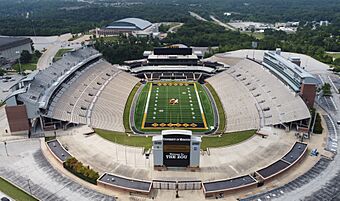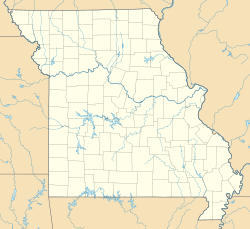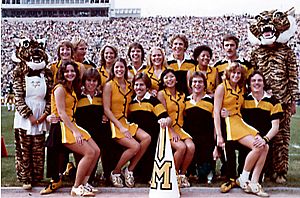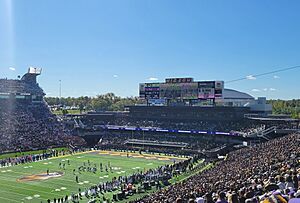Faurot Field facts for kids
|
"The Zou"
|
|

Aerial view of Faurot Field taken in 2021
|
|
| Location | 600 East Stadium Boulevard Columbia, Missouri 65201 |
|---|---|
| Coordinates | 38°56′9″N 92°19′59″W / 38.93583°N 92.33306°W |
| Owner | University of Missouri |
| Operator | University of Missouri |
| Capacity | 62,621 (2019–present)
Former capacity: List
|
| Record attendance | 75,298 |
| Surface | Grass (1926–1984, 1995–2002) Omniturf (1985–1994) FieldTurf (2003–2020) AstroTurf (2021–present) |
| Construction | |
| Broke ground | December 9, 1925 |
| Opened | October 2, 1926 |
| Renovated | 1978, 2003, 2012, 2019 |
| Expanded | 1949–1950, 1961–1965, 1971, 1978, 1996, 2003, 2009, 2014 |
| Construction cost | $525,000 ($8.68 million in 2022 dollars ) |
| Architect | Jamieson and Spearl (original) Ellerbe Becket (renovation) |
| Tenants | |
| Missouri Tigers football (NCAA) (1926–present) |
|
Faurot Field, also known as Memorial Stadium, is a large outdoor sports stadium in Columbia, Missouri. It's located on the campus of the University of Missouri. This stadium is mainly used for American football games. It is the home field for the Missouri Tigers team.
The stadium is the third-largest sports venue in Missouri. Only The Dome at America's Center in St. Louis and Arrowhead Stadium in Kansas City are bigger. In 1972, the playing field was named Faurot Field. This honored Don Faurot, a coach who worked there for a long time.
For many years, the stadium hosted the "Providence Bowl" game. This was a football game between two local high schools, Hickman and Rock Bridge. This tradition ended when the University of Missouri joined the Southeastern Conference. Faurot Field also hosts the state football championships for high schools in Missouri.
The stadium has a unique horseshoe shape, which was common for stadiums built in the early 1900s. The open end of the horseshoe has extra seating. The curved end has a grassy hill where fans can sit. This hill is famous for a huge block "M" made from white painted stones.
Contents
Building the Stadium: Early History
Remembering Heroes: The Stadium's Start
In 1921, people started raising money to build two important places at the university. These were the "Memorial Union" and "Memorial Stadium." Both names honored students and alumni from Mizzou who died in World War I.
Construction for the stadium began in December 1925. It was built in a natural valley between two hills. The first plans were for 25,000 seats. There were ideas to make it much bigger over time, up to 95,000 seats. A fun legend says that a rock crusher and a truck were buried under the field during the first blasting work.
Opening Day and the Rock 'M'
Memorial Stadium officially opened on October 2, 1926. It was dedicated to the 112 alumni and students who died in World War I. The stadium had 25,000 seats and a track around the field. The first game against Tulane was rainy. The field couldn't be covered with grass, so they used sawdust and tree bark. The game ended in a tie, 0-0. After that, real grass was installed.
The famous rock 'M' appeared on October 1, 1927. It was built by new students using leftover rocks from the stadium's construction. This large 'M', about 90 feet wide and 95 feet high, has been a symbol of the stadium ever since. It even provides extra seating for fans.
Stadium Traditions: What Makes Faurot Field Special
The Famous Rock 'M'
The rock "M" is the most well-known symbol of Faurot Field. It sits above the stadium's north end zone. The "M" is made of whitewashed rocks and is very large. Students built it in 1927 using rocks left over from the stadium's construction.
Sometimes, rival fans have tried to change the "M" into other letters as a prank. But the stadium staff and students always protect it. A special tradition for football seniors is to take a rock from the "M" after their last home game. Also, new students help repaint the "M" white every year before the first home game.
Goalposts to Harpos: A Victory Celebration
After a big win, students have a fun tradition. They sometimes take down the goalposts and carry them all the way to Harpos, a popular spot in downtown Columbia. It's a wild way to celebrate an exciting victory!
The MIZ-ZOU Chant: A Roar of Pride
The "M-I-Z," "Z-O-U" chant started in 1976. It began after a game against Ohio State, which had its own famous chant. After a surprising win, Missouri's cheerleaders wanted a special chant for their home games.
They decided on "Mizzou," a nickname for the university. During a game against North Carolina in October 1976, the cheerleaders taught the chant to the fans. Students would yell "MIZ!" and alumni would respond "ZOU!" This quickly became a huge hit. Today, you can yell "MIZ!" almost anywhere in Missouri, and someone will likely shout back "ZOU!"
Now, the chant often starts with the "Big MO" drum, which is the world's largest marching bass drum. When the Tigers get a first down, the announcer says, "First down, M-I-Z..." and the crowd finishes with "Z-O-U!"
Growing and Improving: Stadium Changes Over Time
Adding More Seats: 1949–1978
Faurot Field has been updated many times over the years. Starting in 1949, more seats were added to the stadium. They built a second level of seating on the east side. A new press box was also added for reporters and media. More seating sections were added in the 1960s, completing the second level.
In 1978, the south end zone, which was once open, was filled with 10,800 new seats. This brought the total seating capacity to over 62,000.
The Artificial Turf Era: 1985–1994
In 1985, the natural grass field was replaced with an artificial surface called Omniturf. This was a big change for the stadium. However, many fans and even opposing coaches didn't like the new surface. They called it a "lousy field."
A famous game called "The Fifth Down Game" was played on this artificial turf in 1990. The Omniturf stayed for nearly ten years.
Back to Grass and New Lights: The 1990s
In 1994, a big concert by The Rolling Stones helped raise money to change the field back to natural grass. The last game on the Omniturf was in November 1994.
The artificial turf was removed, and natural grass was put back in 1995. Legendary Coach Don Faurot, who the field is named after, even helped lay the last piece of sod. He had also helped lay the original grass in 1926. As part of these changes, new brick walls were added around the field. These walls honor great Tiger football players by listing their special numbers.
In 1996, four tall light towers were installed. This meant Missouri could start playing night games regularly. In 1997, a large video board was added above the Rock "M" in the north end zone. The stadium also got new concession stands and ticket booths.
Modern Updates: 2000s and Beyond
Before the 1999 season, a new 15-story tower was built. It opened in 2000 and included modern facilities for coaches and media. It also had luxury suites and a restaurant. In 2003, FieldTurf, another type of artificial grass, replaced the natural grass. The traditional "M" at midfield was replaced with a "Power Tiger" logo.
In 2009, a new, larger video scoreboard was installed in the north end zone. It had better video and sound. This new scoreboard was one of the biggest in the Big 12 Conference at the time.
Joining the SEC and Recent Changes
When Missouri joined the Southeastern Conference (SEC) in 2012, more changes were planned. The FieldTurf was redesigned with a bigger "Power Tiger" logo and SEC logos. The end zones got new black and gold "M-I-Z-Z-O-U" designs.
In 2013, the west side press box was updated. New premium suites were added. The "Rock M" and grass hill were moved closer to the north end zone. For the 2014 season, a new upper deck was finished on the east side. This added 5,200 general seats and 800 club seats.
A big renovation of the south end zone was approved in 2017. This project, finished before the 2019 season, added 16 suites and new club areas. It also included a new video board, better concessions, and restrooms. The most exciting part was a new base for the football team. It has new locker rooms, a weight room, meeting rooms, and offices for the team staff. After these changes, the stadium's capacity became 62,621.
In 2023, plans were approved to renovate the north end zone. This started with a new video board and sound system. Future plans include upgrades to the north entrance, new LED lights, better concessions, and a new team store. The project is expected to be finished by the start of the 2026 football season, which will be the stadium's 100th anniversary. Once completed, the stadium will hold about 65,000 fans.
Record Crowds: The Biggest Games
The stadium can currently hold 62,621 people. However, in the past, it could hold even more. The largest crowd ever at Faurot Field was 75,298 fans. This happened on October 4, 1980, when Missouri played Penn State.
All-Time Largest Crowds
- 75,298, vs. Penn State, October 4, 1980
- 75,136, vs. Texas, September 29, 1979
- 74,575, vs. Nebraska, November 3, 1979
- 73,655, vs. Alabama, September 16, 1978
- 72,348, vs. Nebraska, October 15, 1983
- 72,333, vs. Colorado, October 18, 1980
- 72,001, vs. Nebraska, October 24, 1981
- 71,291, vs. Oklahoma, November 17, 1979
- 71,168, vs. Georgia, October 11, 2014
- 71,168, vs. Arkansas, November 28, 2014
Largest Crowds Since 1995
The stadium's seating capacity changed over the years. Here are the biggest crowds since 1995:
- 71,168, vs. Arkansas, November 28, 2014
- 71,168, vs. Georgia, October 11, 2014
- 71,004, vs. Alabama, October 13, 2012
- 71,004, vs. Arizona State, September 15, 2012
- 71,004, vs. Georgia, September 8, 2012
- 71,004, vs. Iowa State, October 15, 2011
- 71,004, vs. Oklahoma, October 23, 2010
- 71,004, vs. Texas, October 24, 2009
- 70,767, vs. Florida, October 10, 2015
- 70,079, vs. Connecticut, September 19, 2015
Images for kids
See also
 In Spanish: Faurot Field para niños
In Spanish: Faurot Field para niños










